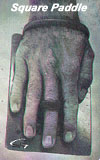Paddles
What are they? Paddles are usually flat cut pieces of plastic that attach to a swimmer's hands (usually with surgical tubing). They are normally slightly larger than the surface area of the hands and come in all sorts of shapes and sizes (see pic below). Some have holes in them and some are made of flexible materials. For our purposes, we group webbed gloves into this category as well. In essence, a swim paddle attaches to the hand and provides the hand with more surface area from which to pull.
What do they do? They make it harder for a swimmer to stroke through the water. This creates great resistance training to build strength. They also cause the swimmer to increase his or her distance per stroke, which helps to lengthen the stroke and simulate shave and taper conditions a little bit better.
As an in-pool type of resistance training, paddles provide a good deal of resistance to the hand and arm during the pull in a way most similar to the actual stroke. As a result, we believe it is one of the best and most efficient strength building methods. By using paddles, you can provide resistance to the exact muscles used, in the exact way that they are needed during a stroke. Other aids and techniques may help provide strength, but they are often missing a lot of crucial muscles and are not training them in the motions that are needed during the activity.
For the same reason that paddles provide more resistance, paddles also provide more distance per stroke (and usually increased speed). The increased surface area will also allow swimmers to go further on each pull and better simulate race conditions without having to sprint. A lap that normally takes 20 strokes to finish may only take 10 with paddles. As a result, the swimmer can get a feel for the timing of swimming with a long stroke. Since most taper-and-shave races will result in an increased distance per stroke, this can be good neuromuscular training.
What to look for in a paddle? The answer depends on what you want to get out of it. The bigger the paddle the more resistance. So, if you want to do shorter sets at higher resistance to build more strength, then a bigger paddle will serve you well. We recommend, however, that you use a paddle that covers your entire hand with a little extra space. This will give you enough resistance, but not too much to cause injury and overly distort your feel for the water.
We also recommend paddles with holes in them. This allows your hand to still feel the water as you pull with the paddle, which is extremely important to swimmers. Since the holes decrease the resistance, a bigger paddle is o.k. Some paddles are square and others come in all sorts of shapes. Try to keep the paddle as close to hand-shaped as possible. It only seems logical that the paddle should emulate actions of the hand as close as possible.

What are the drawbacks? Swimmers will immediately notice how slow they feel after they are done using the paddles. While not necessarily a drawback, it certainly is a little demoralizing in a workout to go back to 'mortal' status.
Some people also believe that paddles (in particular, too much paddle training) can distort a swimmer's feel for the water. Paddles are not a way to train in and of themselves, they are only a complementary way to train. Use them for strength work and leave the majority of swim training to your natural body.
As they say, 'too much of a good thing can be bad'. The same holds true for paddles. Too much paddle training can also cause injury. Many of these injuries can be career threatening, so be very careful, listen to your body, and don't overdo it! The most common injuries from overdosing on the paddles are shoulder injuries, in particular, tendonitis. And, as many swimmers already know, these are not easy injuries to overcome--many never go away.
Use the paddles and use them wisely and they can greatly improve your pull and your entire stroke.